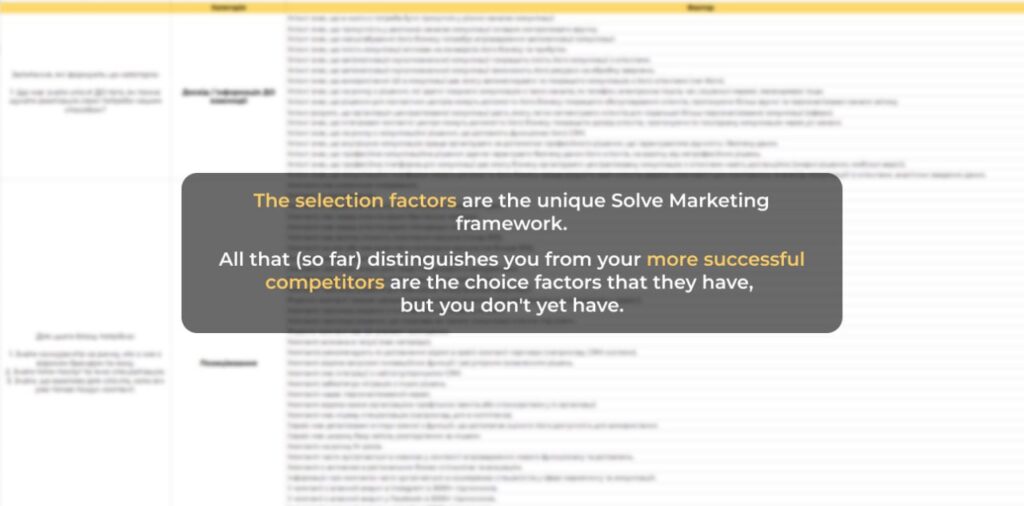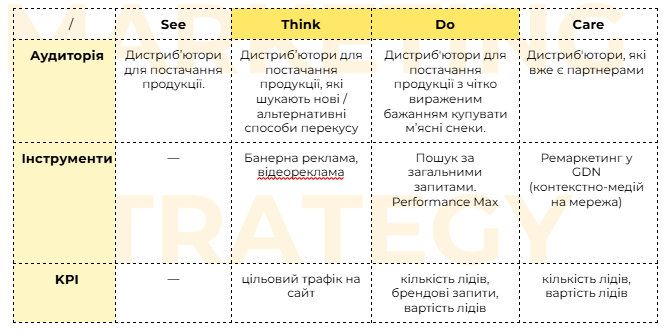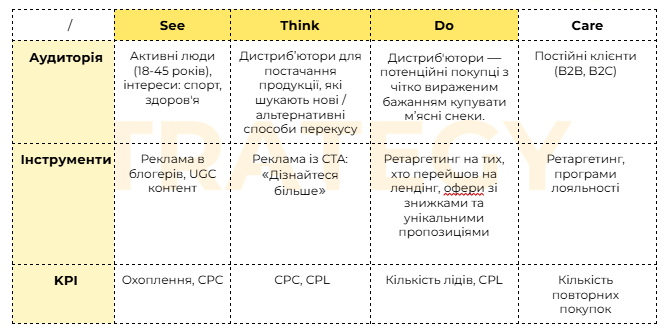People are increasingly concerned about what they eat. They study composition. They avoid sugar. Food is no longer just fuel — it has become an extension of self-care. And even in snacks, people are now looking for not just “something tasty”, but also healthy.
Meat jerky seems to be the perfect answer to this request. Protein and nothing else. The problem is that dozens of brands are trying to give this answer.
Supermarket shelves in Europe are full of meat snacks: from different types of meat, from local producers and international brands. Each of them has occupied its own territory: taste, visual, and price.
It was at this time that the hero of our case study, a new brand of meat jerky, appeared on the Czech market.
This case study is about how to find your niche in a competitive market.
Our work begins here.
| How long did it take to develop the strategy? | 150 hours, 6 working weeks |
| What is the composition of the marketing strategy development team? | Head of Marketing Team, Head of PM Team, Head of Content Team, Project Manager, Operational Marketer, SMM Marketer, Head of PPC Department, PPC Facebook Specialist. |
| How was the result of the work used? | Independent implementation by the client’s specialists |
Let’s get to know each other
We entered the project at a stage when the product already existed, but did not yet have a face, a voice, or a clear place in the market.
CheatMeat are jerkies made from local Czech meat. The format is like chips, but it’s about protein, naturalness and convenience. For those who live an active lifestyle and are looking for a snack that won’t make them feel guilty.
No preservatives. Only clear composition, quality and taste.
The product existed, but the brand did not yet exist.
Sales had not yet started, the website was under development, and Instagram had only basic photos.
The client came to us as a startup in the launch phase. The owners planned to enter the shelves of supermarkets, sports clubs, bars, and health stores with a focus on the B2B segment, where not only packaging but also service, trust, and stability are important.
CheatMeat is not trying to compete with the giants. This brand is about something else:
🟢 naturalness + locality;
🟢 accessibility + recognition;
🟢 flexibility + service.
Our task is to combine all this into a holistic marketing strategy that will help the brand stand out in a market where jerks are no longer a surprise. And at the same time, to preserve the main thing: the sense of naturalness, localism, and trust that CheatMeat relies on.
How is Europe changing its eating habits?
In recent years, the European consumer has changed.
Instead of “just having a bite to eat”, the demand has emerged: having a snack with benefits.
Sweet bars, pastries, and chips are fading into the background.
A smart alternative is coming to the scene: tasty, convenient, rich in protein, without sugar and preservatives.
Jerkies are not just a trend — they are growing steadily:
- The European meat snacks market reached $3.17bn in 2023.
- The expected average annual growth until 2030 is 8.9% CAGR.
- The jerk category is becoming increasingly popular due to its versatility and high protein content.
Who drives demand?
Young people under 35 are those who live at a fast pace, constantly between meetings, training, and travelling.
But older generations are also gradually changing their habits.
Today, jerkies are no longer just “meat in a bag”. It is:
🥩 lunch for an office worker;
💪 a snack for an athlete;
🍻 snacks in the company with craft beer;
🎁 an element of gift boxes with a wow effect.
Where are they looked for? How are they bought?
Today, meat snacks are part of the context. Part of a habit. That’s why people buy them:
- in retail — Tesco, Lidl, Carrefour, Metro, Billa;
- in coffee shops and healthy stores, where people choose something “without excess”;
- at petrol stations, railway stations, airports, where you need a quick and nutritious snack;
- in online stores and marketplaces when you want something new;
- at festivals and fairs as part of the experience and tasting.
In the Czech Republic, interest in everything local continues to grow — consumers want to know where their food comes from and are increasingly choosing local brands.
Today, the winner is the one who understands the market not only by numbers, but through consumer behaviour, choice and memory.
Understanding the market helps to assess the efforts that need to be made to get into a classic retail store, a coffee shop or on the shelves of online stores. The main needs that motivate a client to order a marketing strategy are:
✅ a desire to act consciously;
✅ to estimate the cost of testing hypotheses before making significant expenditures;
✅ to understand what choices are available, how to change the idea if plan “A” does not work.
Therefore, market research is aimed at finding the answer to how to achieve the planned indicators and what resources will be needed for this. Read more about how we work on marketing strategies here.
Data collection → action
Before entering a market, you need to know who is already there, how they talk to customers, and what gaps in their offer will help customers choose you.
To understand this, we compiled a list of our main competitors — from small local brands to European giants. We dived into their products, flavour profiles, positioning, ingredients, packaging, and promises.
This “immersion” helped us to see the customers of CheatMeat: expectations, triggers, real needs — both in the B2B segment and the end consumer.
We took into account the seasonality, communication style, and product depth.
While analysing websites, social media, and packaging, we asked ourselves:
- Will the customer understand the difference between this product in 5 seconds?
- Will the customer feel the taste even before opening the package?
- And most importantly, will the customer remember this brand tomorrow?
Insight: before you start analysing the market, you never know what will attract attention. For example, sometimes a competitor’s website will make you write out interesting UX solutions for an hour. Another will help you see the gaps in your own product line.
We paid special attention to the analysis of packaging and the product itself. To do this, we created a comparative table with prices, and looked at trends in packaging and flavours
We found:
- how to improve product packaging to stand out in this market;
- how the welcome funnel works, and even found errors in subscriptions;
- where the content leads the user and where it just lies dead weight;
- who sells with stories and who sells with price alone;
- how brands create a sense of community, emotional engagement, and loyalty.
- what channels brands use to advertise themselves.
We also compared how competitors run social media, and it turned out that despite global budgets, they provide opportunities for new players: some constantly ignore the competition, some simply leak content from Instagram to Facebook without adaptation, some run social media for the sake of it.
In-depth competitive analysis is the basis for strong positioning.
Get a strategic approach to your business development.
Lead generation strategy
When a new brand enters the market, the main thing is not just to make a name for itself, but to do it wisely. With a clear hypothesis testing plan. Without emotional outbursts and, as a result, tens of thousands of dollars of advertising budgets burnt.
We asked ourselves key questions:
— Which advertising tools are effective for CheatMeat?
— How to make every cent work for the brand and not just disappear in the coverage?
— How to measure the result and predict growth?
— How much will one order really cost?
— How to build a funnel separately for B2C and B2B directions?
All this formed the basis of the lead generation strategy. Our task was clear:
🔹 launch sales through Google and Meta;
🔹 test hypotheses;
🔹 build working funnels for both segments.
We started with the basics — the distribution of the audience by sales funnel:
It is not uncommon for a manufacturer to outsource final sales to its distributors. In this case, everyone does their own thing: the manufacturer produces and the distributor sells.
Why is attracting B2B customers a profitable strategy for manufacturers?
🔸 It ensures the dynamics of volume growth without the need to increase the cost of servicing your own retail.
🔸 Over the long run, B2B customers are the most profitable in terms of the ratio of cost of acquisition and profit.
But you should not forget about the end consumer. After the launch in supermarkets or fitness chains, you can gradually scale the B2C direction.
📩 Do you need a strategy that will help you not only spend your budget but also receive a stream of sales and partnership requests? Come for a free consultation and we will tell you how to take your brand to the next level.
What really influences the choice?
The decision to buy is not always about taste, composition and the story behind the product. Some people choose because they heard a recommendation from a blogger. Some people choose it because they saw stylish packaging on a shelf. And someone saw a witty video in a feed at the right time and decided to try it.
All these variations in why a customer decides to make a purchase form a “cloud” of choice factors.

The choice factors framework — our unique approach to analysing customer decisions
We have created our own methodology to help you understand why customers choose you or go to your competitors. It’s the choice factors framework, which is based on the realisation that every customer makes a decision based on their own unique set of factors.
We have identified several key groups of factors that have the greatest impact on choice:
1. Awareness of your approach
А customer will not choose something they do not know about. For example, if a person has never heard of laser vision correction, they will continue to choose between glasses and lenses. Your task is to inform the client about the existence of your unique solution and explain how it meets their needs.
2. Positioning and meeting expectations
The customer is always assessing whether your positioning matches their expectations. Are your values, communication style, tone, and visual design close to his or her heart? This is where the first impression is formed and often determines whether the next step will be taken.
3. Experience of interacting with the company
From the first meeting to the conclusion of the deal, all the details matter:
- how convenient it is to communicate with you;
- how quickly you respond;
- whether your presentations and documents are clear;
- how logical and simple the process of cooperation is.
All of these experiences either inspire the customer to continue contact or push them away. That’s why our task is to design the ideal customer journey that deliberately leads to a “yes”.
Why do customers choose competitors?
Perhaps they have already implemented the choice factors that you have not yet implemented. We help identify these gaps and turn them into your competitive advantage.
We don’t wait for the customer to “mature”.
We use choice factors to turn a casual snack into a conscious choice.
Our team has already researched more than 100 factors that influence customer decisions. Based on this, we have created clear, practical recommendations for business growth.
👉 Read more about the choice factors framework here.
Positioning for CheatMeat
This part of the case study is the heart of the marketing strategy. Here we collect all the senses and analytics to create an effective brand and product line positioning. Read this article to find out how positioning works and what steps you need to go through to develop it.
What we did:
- Conducted market research and saw the positioning of the main players.
- Analysed competitors, identified the strengths and weaknesses of their communication.
- We studied the key choice factors and formulated a list of powerful choice factors for positioning.
- We conducted audience segmentation to take into account all segments and identify ways to niche.
All of this became the basis for a sound, strong positioning concept that takes into account market realities, customer desires and needs, competitors’ weaknesses and unique potential.
It was important for us to highlight the existing advantages in a single phrase:
CheatMeat — opravdové maso bez omáčky. Vyrobeno v Česku.
CheatMeat is real meat without water. Made in the Czech Republic.
Do you have a positioning that reveals your brand?
Strategy development
The strategy is the result of a compilation of all the steps taken: from market analysis, formation of choice factors, development of positioning, content strategy, competitor analysis and other important components that we have described above.
In the process, we:
- Immersed ourselves in the product to see what makes it valuable.
- We analysed competitors, understood who they are, what they broadcast and what they lack.
- We studied the consumer: not only who they are, but also how they think, what is important to them, why they choose and why they refuse.
- And only then did we formulate a positioning that builds a bridge between the product and people.
- We created a lead generation strategy to attract customers and generate revenue.
Each step was necessary to complete the puzzle.
An effective strategy provides an answer on how to achieve the planned results. This is a step-by-step plan, each step of which is justified by analytics.
What is the result?
A marketing strategy for a startup is like a map, without which it is easy to get lost. For an established business, it’s a breath of fresh air, a chance to get out of the operational routine and see where the brand is really headed.
We met CheatMeat at the stage when the product was already created. And it was a high-quality, honest product. There was no plan for development. We helped to create a coherent story — with positioning, a clear vision of the brand’s place among competitors, audience segmentation, a lead generation strategy, and a promotion plan for at least a few years ahead.
- If you’re just starting out and don’t want to waste your budget, a strategy will help you act confidently from the first step.
- If you’ve been on the market for a long time but still don’t feel the comprehensive growth and predictable results, the strategy will help you prioritise and focus your brand development efforts.
🔥 During a free consultation, we will discuss your business and set goals. Just like meat jerky — no water. Only what works and gives energy for your development.








